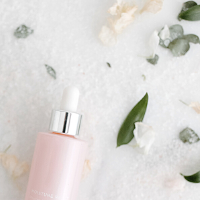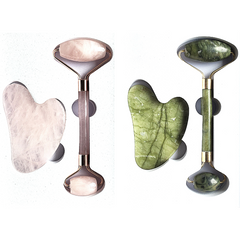How to Build a Skincare Routine
| Yong Li

Whether you’re just tip-toeing into creating a skincare routine or you’ve had an established routine for years, determining the best order in which to apply products can be confusing, especially if you add a new product into your lineup.
-
Does vitamin C serum go before or after facial oil?
-
What about hyaluronic acid?
-
And where in the lineup does a hydrating spray/toner fall?
Don’t worry — we’ve got you.
This step-by-step guide will help to make sense of when to apply your products and guide you through building a skincare routine that allows the maximum amount of skin-loving ingredients to penetrate your epidermis so that you reap their full intended benefits.
Morning Routine:
STEP 1
Cleanse or simply rinse with water.
Cleanse with a gentle cleanser or skip cleanser altogether and simply rinse your face with tepid water.
Cleansing too frequently — especially if you have normal to dry skin — may have a drying effect and compromise the skin barrier. For many people, a simple rinse to remove any residue from the prior night’s skincare product application is sufficient.
STEP 2
Water-based products, hydrators.
As a general rule, layer your products from thinnest to thickest consistency, although a product that is mostly water-based but has some oils can go toward the end. The most water-based of all your products is likely to be a hydrosol/toner, so start with that.
We recommend applying a hydrosol spray before anything else for two reasons:
Reason #1. Applying your skincare products to damp skin helps the ingredients more easily absorb into your skin.
Reason #2. If you’re applying any products that contain hyaluronic acid (HA), you’ll want to make sure that your face is damp prior to application. This is because hyaluronic acid holds up to 1000x its weight in water by binding to water molecules nearby. If HA can't find a sufficient amount of water molecules in its environment, it will pull water from the deeper layers of your skin, thereby actually making your skin drier. HA can make a big difference in the hydration and plumpness to your skin, but applying it to damp skin is key. Spritzing your face with a hydrosol immediately before applying HA is ideal.
Learn more about hyaluronic acid >>
Examples of Step 2 products:
Hydrosol spray (aromatic water)
Rose, Neroli (orange blossom), Lindenflower, Melissa (lemon balm)
Ageless Skin Serum
(contains vitamin C, collagen peptides, and hyaluronic acid)
STEP 3
Lighter oils, creamier serums, eye serums.
Most oils are emollients — not occlusives — which means they penetrate the skin's top layer (epidermis) and help to repair the skin’s barrier. A facial oil will also assist with locking in the hydration applied in step two. Examples of emollients include ceramides, cholesterol, fatty acids. Occlusives, on the other hand, don’t penetrate the skin and, instead, form a top protective layer that prevents Transepidermal Water Loss (TEWL). Examples of occlusives are beeswax, candelilla wax, and cocoa butter.
A common misconception is that people with oily skin should not apply a facial oil. The truth is, all skin types — even oily — can benefit from a facial oil. There are, however, oils that are better suited for one skin type over another. Skin that more on the oily side may do better with apricot and jojoba oils, while mature and drier skin types can tolerate heavier oils such as avocado and castor.
Examples of Step 3 products:
True Perfection Natural Aging Defense
Cactus Seed (Prickly Pear) Oil Antioxidant Serum
Snow Lotus facial oil serum - for oily, sensitive, combo, or mature skin
STEP 4
Moisturizer, sunscreen.
If you use multiple products, layer them from lightest to heaviest in consistency. Sunscreen is always the last skincare step.
Depending on your skin type, you may or may not choose to apply a moisturizer during the day. Sunscreen, however, is a must every day of the year.
Many sunscreens now offer either moisturizing or mattifying properties, along with the UV protection.
Example of Step 4 product:
Herbal moisturizing lotion
Night Routine:
STEP 1
Double cleanse.
While you might be able to get away with a simple water rinse in the morning, if you choose, a double cleanse at night is crucial in order to remove the dirt and grime from the day.
Start with an oil-based cleanser for the first cleanse to dissolve makeup, sunscreen, etc. The second cleanse should be with a gentle cleanser suitable for your skin type.
Examples of Step 1 products:
Deep cleansing oil
Herbal complexion soap
STEP 2
Water-based products, humectants, active ingredients.
As a general rule, layer your products from thinnest to thickest consistency, although a product that is mostly water-based but has some oils can go toward the end. The most water-based of all your products is likely to be a hydrosol/toner, so start with that.
As a general rule, layer your products from thinnest to thickest consistency, although a product that is mostly water-based but has some oils can go toward the end. The most water-based of all your products is likely to be a hydrosol/toner, so start with that.
We recommend applying a hydrosol spray before anything else for two reasons:
Reason #1. Applying your skincare products to damp skin helps the ingredients to more easily absorb into the skin.
Reason #2. If you’re applying any products that contain hyaluronic acid (HA), applying HA to damp skin is crucial. For details about why this is important, refer to the HA information within the morning routine above.
Examples of Step 2 products:
Hydrosol spray (aromatic water)
Rose, Helichrysum, Lindenflower, White Sage
Hyaluronic Acid (HA) serum
Collagen Peptide serum
STEP 3
Lighter oils, creamier serums, eye serums.
Most oils are emollients which mean they penetrate the skin's top layer (epidermis) and help to restore the skin's barrier.
Examples of Step 3 products:
True Perfection Wrinkle Serum
True Perfection Eye Serum
ReDermaVive Dr. Sun’s Anti-Aging Facial Oil Serum
STEP 4
Moisturizers/Creme.
If you use multiple products, layer them from lightest to heaviest consistency.
At night, you can get away with applying a heavier moisturizer than what you may use during the day. Night time is when an occlusive works well to form a top protective layer over your other skincare ingredients and prevent Transepidermal Water Loss (TEWL). Examples of occlusives are beeswax and candelilla wax.
Example of Step 4 product:
ReDermaVive Chinese Herbal Night Crème
P.S. Don’t forget those lips! Apply ReDermaVive’s Chinese Herbal Lip Balm before drifting off to sleep and wake up to silky smooth lips!
Did you know? People’s Herbs has a Licensed Esthetician available for no-cost phone or email consultations to answer questions and provide personalized product recommendations for your specific skin concerns. Email info@peoplesherbs.com to schedule your free chat with our Licensed Esthetician today!
You may also like:
-
Chinese Herbal Shampoo - Blue Poppy
-
Hair & Scalp Serum - Snow Lotus
-
Anti-Aging Facial Massage Set - gua sha + facial roller
-
Bronze Kansa Facial Massage Wand
This content is for informational purposes only and is not intended to be a substitute for professional medical advice, diagnosis, or treatment. Always seek the advice of your health provider with questions you may have about a medical condition.
How to Build a Skincare Routine - Morning and Night
People's Herbs - Ancient Beauty in a Modern World
www.PeoplesHerbs.com
People's Herbs - Ancient Beauty in a Modern World
www.PeoplesHerbs.com




